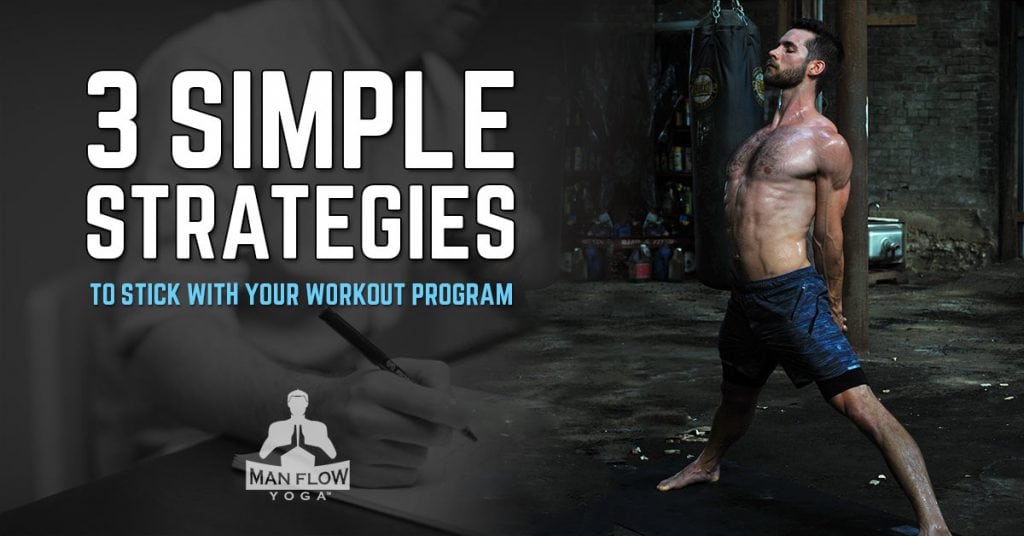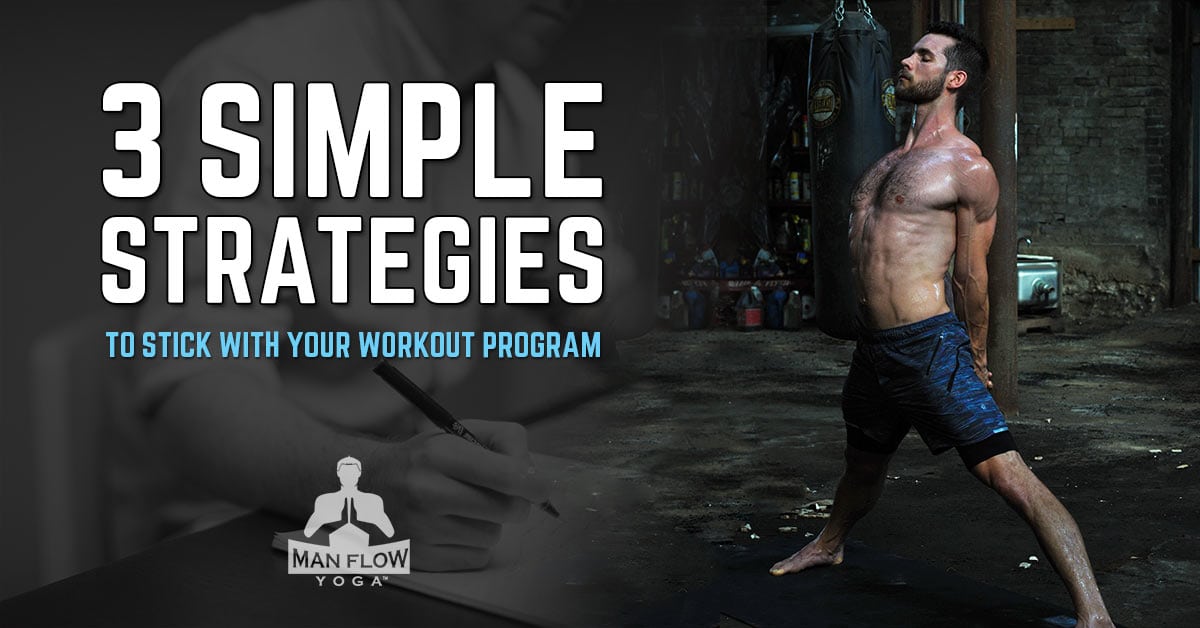I’m writing this blog to give you 3 simple strategies you can combine to make sure you stick to your workouts, stay motivated, and get the results you want.
It starts with a story.
I was having a webcam lesson with John, a young man (a few years younger than me, at least) in the United States Air Force. We had just finished the workout portion of the lesson, and we were in the midst of wrapping up the online session.
I asked him, as I do at the end of all my classes, sessions, or workouts, “Do you have any questions?”
He did. But it didn’t have to do with technique, workout progression, or physical fitness. Instead, he asked:
“How do you stay focused on your workouts when you have so much going on? Especially when you start to have issues or additional stress with work, relationships, or life changes. What can you do to stay focused and motivated?”
I paused to think before I began speaking. But only momentarily, because even though I hadn’t said the answer aloud before, I already knew. I had thought about it for years, and the answers I developed to these same questions I asked myself long ago had already helped me push through hundreds of workouts – not to mention tons of other situations that didn’t involve working out.
Here’s what I told John: The most important part is remembering WHY your fitness is important to you in the first place. I’m not talking about a general “because being healthy is good for you” answer. I’m talking about using critical introspection to figure out are those deeper, powerful emotions driving you to make healthier choices, especially when those choices make life harder for you.
When you ask yourself why you work out, and then CONTINUE to ask yourself why until you get to the real answer, you peel back the onion of yourself. Eventually, you find an extremely powerful motivator; one that makes you say, “Whoa, s***. That’s deep!”
I’ll give you an example of what this process looks like,
and use myself as an example:
Why do you do yoga?
Because I want to be in great shape for as long as I possibly can.
Why do you want to be in great shape for as long as you possibly can?
Because I don’t ever want to get to the point where I am unable to move and do the things I enjoy doing?
Why don’t you want to get to that point?
Because I HATE the feeling of being helpless. I HATE the feeling of not being able to do what I want to do.
As an athlete – in youth, high school, college, and beyond – I’ve had to sit out of tons of games and practices because I was injured. I hate the feeling of watching somebody else do what I want to do, and not being able to do anything about it.
I literally have nightmares about getting to the lacrosse field, getting ready to play, and then realizing I forgot an essential piece of equipment. Sometimes it’s my cleats, my gloves, or my lacrosse stick. But it’s not about the missing equipment. The missing equipment is a metaphor for my lack of physical ability. I’m terrified of getting to that point.
But I know that by I can prevent that from happening by exercising, doing yoga, and continuing to make my body stronger and more resilient to injury on a regular basis. So I constantly push myself to better in these areas, because I know it’s only going to become more difficult as I get older, but the more I do now, the easier it will be later on.
From this process of asking “why” until I get to a more powerful answer, I discover that I work out because I’m scared of being physically incapable of doing what I want to do. That FEAR is what drives me to exercise, to take care of my body, to avoid unhealthy activities, and to constantly engage in healthy practices.
So that’s the first part of my answer – figure out the real motivation that’s driving to you to exercise (to do yoga) in the first place. And if it isn’t a powerful answer, keep digging.
The second part of this answer helps you make yoga something you do regularly, without fail – and it’s simpler than you think. Designate a specific time of day, every day of the week, for yoga, and then make it a non-negotiable priority.
In essence, you create a weekly yoga workout schedule for yourself, and then you stick to it. Before you read on – you don’t have to do yoga for 60 minutes every day. 10 minutes can be super helpful. Some days you may do yoga in the evening for just 20 minutes, and at other times you may have a full 45-60 minutes set aside in the morning. If you have the same work schedule every day, you won’t have to worry about this as much. If you have a schedule that fluctuates, you plan around it. Just make sure you set up a time that you know you can commit to yoga, and stick to it.
By making your yoga workouts a non-negotiable priority, you’re saying that you’ve already made the choice to do it – it’s the single priority for that specific time, and everything else takes a back seat. That means that no matter what comes up (short of an emergency), you do yoga at that time.
Have to catch up on work? Figure out another time to do that. Doing yoga helps you stay focused, improves your concentration, and helps you sleep better. It makes you work better. Thinking about it this week, you can’t afford not to do it.
Friend wants to get together for drinks? You can do that after yoga. As a non-negotiable priority, this is something that isn’t up for discussion. You’re busy then, but you can do it another time. (Maybe afterwards, as a reward for a solid yoga workout!)
Set aside specific times of the day, every day of the week, for yoga, and make those designated yoga times a non-negotiable priority. Do this, and it will be extremely difficult for you to NOT to get results with your yoga program.
Thirdly, you do your best. This sounds simple, and it is. But there is an element of realism to it that you must consider. You have to understand that your best fluctuates on a daily basis. Doing your best doesn’t mean you always do better than the day before. That wouldn’t be realistic. Doing your best over time means doing the best you can relative to your abilities that day.
Your body isn’t constantly at 100% – and that’s 100% normal. Some days you’ll be full of energy, and other days you’ll feel like crap. Sometimes you don’t sleep very well. Other times you will have done a really difficult workout the day before, and your body is sore. You can’t expect your body to be at its best all the time, and if you do, you could end up getting injured.
The important thing is to do the best you can with what you have at the given time. If you can commit to that, you will be shocked at how far you’ll come in just a few weeks of consistent, high level effort.
Let’s recap:
- Figure out your WHY. What’s the real reason driving you to work out? What’s the hope or fear motivating you to push yourself, live a healthier lifestyle, and get results?
- Create a schedule with specific times every day of the week designated for yoga, and stick to those yoga workouts as non-negotiable priorities. You don’t think about whether or not you’re going to do it – you just do.
- Do the best you can relative to your ability that day. Some days your best will be better than other days, but if you do the best you can every day, you will amaze yourself with the results.
Here are 2 things I want you to do right now – and it will take no more than 5 minutes, but it will pay you back 1000 fold over time.
- Create your yoga schedule. Make sure it’s manageable. You should be 99% confident you can stick to it. Write it out somewhere you can see it, or schedule each daily yoga workout as a weekly recurring event in your phone / online calendar.
- Figure out what’s driving you to do yoga. Take a moment and REALLY think hard about what’s driving you to exercise. Knowing and fully understanding this reason is extremely powerful, and can give you the energy to help you push through setbacks or your own unwillingness to exercise.
And of course, remember to do your best. 🙂
BONUS: If I had to give you just one more strategy, it would be keeping a wellness log. This means purchasing a notebook and designating it solely as a tool for tracking and recording your workouts.
Your wellness log is a physical representation of all of the effort and hard work you’ve put into a workout program. It’s something to take pride in, and it’s been proven to help you stick with your workouts, and get better results.
In this notebook, you record as little or as much as you want about each workout you do. You could simply list the title of the workout along with a brief description of what you did, or you could write a few sentences documenting the more interesting parts of the workout. Did you get deeper in one pose than you usually do? Were you able to hold one posture longer than you’ve ever held it before? Use your workout log to celebrate these little victories.
I hope you found this blog useful. I look forward to you continuing to get stronger with Guyoga, and any other fitness programs you may be using! Don’t forget, you also have the Man Flow Yoga Community to help you out. Click here if you haven’t already joined.
I’ll see you on the workouts!
Dean
PS – Want to learn more about uncovering your why? Click below to check out Week 1 of Be The Better You: Find Your Why. I developed this (FREE) 6-week program to help people develop the mindsets, practices, and habits to be successful with your fitness, and I’d love for you to utilize it.
Be The Better You: Week 1 – Find Your Why
Other Resources:
Yoga Scheduling – The Most Effective Methods for Integrating Yoga into Your Workout Routine
Nighttime Routine – Do this before bed for an amazing night of sleep.
MFY Squat Challenge – 30 days, 30 squats. Can you keep up?
.entry-featured{display:none;}



Thanks, Dean.
The “why?” step is the hardest, and most important!
Av
So true, Av! It can be a draining, emotional task.